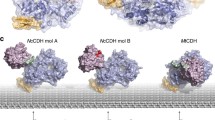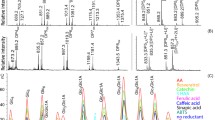Abstract
A special low-molecular-weight peptide named Gt factor, was isolated and purified from the extracellular culture of brown-rot fungi Gloeophyllum trabeum via gel filtration chromatography and HPLC. It has been shown to reduce Fe3+ to Fe2+. Electron paramagnetic resonance (EPR) spectroscopy revealed Gt factor was able to drive H2O2 generation via a superoxide anion O2 .- intermediate and mediate the formation of hydroxyl radical HO. in the presence of O2. All the results indicated that Gt factor could oxidize the cellulose, disrupt the inter- and intrahydrogen bonds in cellulose chains by a HO. -involved mechanism. This resulted in depolymerization of the cellulose, which made it accessible for further enzymatic hydrolysis.
Similar content being viewed by others
References
Carpita N, Sabularse D, Montezinos D & Delmer DP (1979) Determination of the pore size of cell walls of living plant cells. Science 205: 1144-1147.
Enoki A, Tanaka H & Fuse G (1989) Relationship between degradation of wood and production of H2O2-producing or one-electron oxidases by brown-rot fungi. Wood Sci. Technol. 23: 1-12.
Enoki A, Hirano T, Tanaka H (1992) Extracellular substance from the brown-rot basidiomycete Gloeophyllum trabeum that produces and reduces hydrogen peroxide. Mater Org. 27: 247-261.
Enoki A, Itakura S & Tanaka H (1997) The involvement of extracellular substances for reducing molecular oxygen to hydroxyl radical and ferric iron to ferrous iron in wood degradation by wood decay fungi. J. Biotechnol. 53: 265-272.
Fekete FA, Chandhoke V & Jellison J (1989) Iron-binding compounds produced by wood-decaying Basidiomycetes. Appl. Environ. Microbiol. 55: 2720-2722.
Flournoy DS, Kirk TK & Highley TL (1991) Wood decay by brown-rot fungi: Changes in pore structure and cell wall volume. Holzforschung 45: 383-388.
Gibbs CR (1976) Characterization and application of ferrozine iron reagent as a ferrous iron indicator. Anal. Chem. 48: 1197-1201.
Goodell B, Jellison J, Liu J, Daniel G, Paszczynski A, Fekete F, Krishnamurthy S, Jun L & XU G (1997) Low molecular weight chelators and phenolic compounds isolated from wood decay fungi and their role in the fungal biodegrdation of wood. J. Biotechnol. 53: 133-162.
Halliwell G (1961) The action of cellulolytic enzymes from Myrothecium verrucaria. Biochem. J. 79: 185-192.
Halliwell G (1965) Catalytic decomposition of cellulose under biological conditions. Biochem. J. 95: 35-40.
Halliwell B & Getteridge JMC (1985) Hydroxyl radicals assayed by aromatic hydroxylation and dexyribose degradation. In: Green-Wald RA (Ed) Handbook of Methods for Oxygen Radical Research (pp 177-180). CRC Press, Boca Raton, FL.
Highley TL (1988) Cellulolytic activity of brown-rot and white-rot fungi on solid media. Holzforchung 42: 211-216.
Jellison J, Chandhoke V, Goodell B & Fekete F (1991) The isolation and immunolocalization of iron-binding compounds produced by Gloeophyllum trabeum. Appl. Microbiol. Biotechnol. 35: 805-809.
Koenigs JW (1974) Hydrogen peroxide and iron: A proposed system for decomposition of wood by brown-rot Basidiomycetes. Wood fiber 6: 66-80.
Murmanis L, Highley TL & Palmer JG (1988) The action isolated brown-rot cell-free culture filtrate, H2O2-Fe(II), and the combination of both on wood. Wood Sci. Technol. 22: 59-66.
Sinnott ML (1988) The cellobiohydrolases of Trichoderma reesei: A review of indirect and direct evidence that their function is not just glycoside bond hydrolysis. Biochem. Soc. Trans. 26: 160-164.
Tripp VW (1971) Measurement of crystallinity. In: Bikales NM & Segel L (Eds) Cellulose and Cellulose Derivatives (pp 319-320). Wiley Iterscience, New York.
Uchida K & Kawakishi S (1988) Interaction of (1 → 4)-and (1 → 6)-linked disaccharides with the fenton reagent under physiological conditions. Carbohydrate Res. 173: 89-99.
Veness RG & Evans CS (1989) The role of hydrogen peroxide in the degradation of crytalline cellulose by basidiomycete fungi. J. Gen. Microbiol. 135: 2799-2806.
Xu G & Goodell B (2001) Mechanism of wood degradation by brown-rot fungi: chelator-mediated cellulose degradation and binding of iron by cellulose. J. Biotechnol. 27: 43-57.
Zohar K, Kenneth AJ & Kenneth EH (1999) Low molecular weight chelators and phenolic compounds isolated from wood decay fungi and their role in the fungal biodegrdation of wood. FEBS Lett. 446: 49-54.
Author information
Authors and Affiliations
Rights and permissions
About this article
Cite this article
Wang, W., Gao, P. A peptide-mediated and hydroxyl radical HO.-involved oxidative degradation of cellulose by brown-rot fungi. Biodegradation 13, 383–394 (2002). https://doi.org/10.1023/A:1022848414100
Issue Date:
DOI: https://doi.org/10.1023/A:1022848414100




